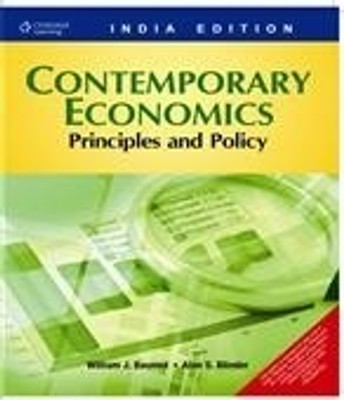Contemporary Economics 1st Edition(English, Paperback, Baumol William J.)
Quick Overview
Product Price Comparison
This text is well-known for using the Keynesian model in the teaching of economics; yet, in recent editions, the authors expanded coverage of the growth model considerably to achieve more balanced coverage. The text uses the aggregate supply/aggregate demand model as a fundamental tool for learning macroeconomics. It achieves the right level of rigor and detail, presenting complicated concepts in a relatively straightforward manner and using timely economic data. Using puzzles, issues, and well-developed examples, the authors provide a good balance of theory to application, allowing you to relate the materials to your everyday life. Key Feature There is expanded coverage on developing economies (China and India), as well as coverage on outsourcing The book provides analysis of human capital's impact on economic growth, including a discussion on minimum wage and household protection More developed discussion of consumer choice has been added, including expanded coverage on budget limitations and constraints when discussing consumer theory The authors include new material on banking, energy and the history of economics, as well as new analysis of the mortgage crisis of 2007 Table of Contents Part I: Getting Acquainted with Economics 1. What Is Economics? 2. The Economy: Myth and Reality 3. The Fundamental Economic Problem: Scarcity and Choice 4. Supply and Demand: An Initial LookPart II: The Building Blocks of Demand and Supply 5. Consumer Choice: Individual and Market Demand 6. Demand and Elasticity 7. Production, Inputs, and Cost: Building Blocks for Supply Analysis 8. Output, Price, and Profit: The Importance of Marginal Analysis 9. Investing in Business:Stocks and Bonds. Part III: Markets and The Price System 10. The Firm and the Industry under Perfect Competition 11. Monopoly 12. Between Competition and Monopoly 13. Limiting Market Power: Regulation and Antitrust Part IV: The Virtues and Limitations of Markets 14. The Case for Free Markets I: The Price System 15. The Shortcomings of Free Markets 16. The Market's Prime Achievement: Innovation and Growth 17. Externalities, the Environment and Natural Resources 18. Taxation and Resource Allocation Part V: The Distribution of Income 19. Pricing the Factors of Production 20. Labor and Entrepreneurship: The Human Inputs 21. Poverty, Inequality, and Discrimination Part VI: The Macro-Economy: Aggregate Supply and Demand 22. An Introduction to Macroeconomics 23. The Goals of Macroeconomic Policy 24. Economic Growth: Theory and Policy 25. Aggregate Demand and the Powerful Consumer 26. Demand-Side Equilibrium: Unemployment or Inflation? 27. Bringing in the Supply Side: Unemployment and Inflation? Part VII: Fiscal and Monetary Policy 28. Managing Aggregate Demand: Fiscal Policy 29. Money and the Banking System 30. Managing Aggregate Demand: Monetary Policy 31. The Debate Over Monetary and Fiscal Policy 32. Fiscal Policy, Monetary Policy, and Growth 33. The Trade-off between Inflation and Unemployment Part VIII: The United States in The World Economy 34. The International Monetary System: Order or Disorder? 35. International Trade and Comparative Advantage 36. Exchange Rates and the Macro-economy


